Mulch is the perfect security blanket for young veggies. It prevents weeds, insulates soil during chilly winters, keeps plants safe from diseases, and prevents evaporation by locking in soil moisture.
But vegetable gardens require specific types of mulch to thrive. Let’s walk through the 8 best mulches for vegetable gardens so you can choose the right mulch options for a healthy green garden bed.
You are watching: 8 Best Mulches for Vegetable Gardens
What is mulch?
Mulch is a material such as wood chips, sawdust, rubber or gravel, used to cover your soil. It reduces erosion, keeps soil temperatures stable, prevents weeds, and retains soil moisture for healthy roots.
Mulching can be done all around your yard, but mulching around vegetable gardens is an especially beneficial landscaping practice. It means less weeding and watering for you and more protection for your tender vegetables.
There are two types of mulch: Organic and inorganic.
Organic mulch: Organic materials decompose, and as they decompose, they return nutrients and organic matter to the soil and improve soil texture and quality. This makes it especially beneficial for root health and plant growth. If you want to give your veggies the best soil for long-term growth, organic mulch is the way to go.
Organic mulch includes:
- Leaves
- Pine needles
- Compost
- Grass clippings
- Wood chips
- Straw
Inorganic mulch: Does not decompose, or it decomposes very slowly. Inorganic mulches last longer than organic mulch and are highly effective weed barriers, which may be just what your vegetables need. If you want to prevent weeds without reapplying mulch each season, inorganic mulch is ideal.
Inorganic mulch includes:
- Landscape fabrics
- Black plastic
- Gravel and stones
- Rubber
8 best vegetable garden mulches
1. Compost
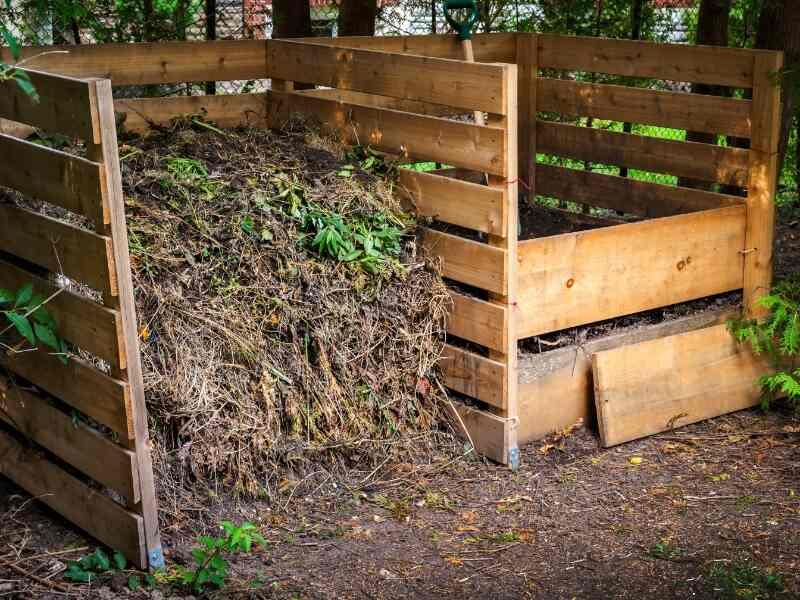
Compost is perfect for vegetable gardeners because it both improves soil quality and structure and keeps roots safe and insulated. It’s a nutrient-rich mixture of decomposing organic matter, from table scraps to grass clippings, and you can make it yourself. The result? A garden filled with healthy soil and flourishing plants.
Compost is a food source and habitat for beneficial bacteria and earthworms that aerate your soil, break down organic matter, and release chemicals that prevent plant diseases. Earthworms are the perfect guests to make your veggie garden thrive.
If you’re creating your own compost, avoid tossing in meat, bones, foods with a high-fat content (like cheese, salad dressings, or oils), diseased plants, tough weeds, and animal waste.
Layer depth: 2 to 3 inches
Pros of compost:
- Excellent erosion resistance
- Great for organic, DIY gardening
- Breaks down rapidly to increase soil nutrients
- Nutrient-rich
Cons of compost:
- Not as good at suppressing weeds as black plastic
- Requires a waiting period as mulch material decomposes
- Can attract pests (raccoons, rats, ants, and earwigs)
Pro Tip: Want to give your veggies an extra nutrient boost? Till 1 to 3 inches of finished compost (humus) into your soil at the end of the growing season. It’s an excellent soil amendment that will get your plants growing strong in spring.
2. Grass clippings
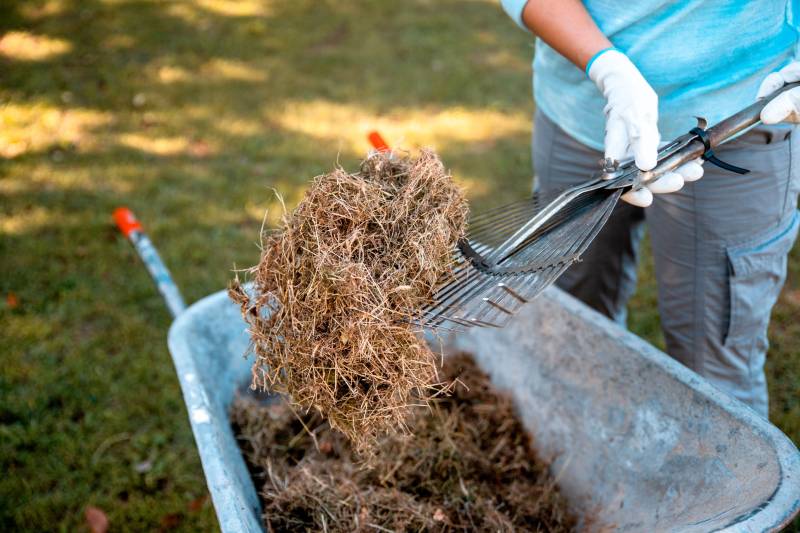
Dry grass clippings are a favorite with thrifty, organic gardeners. Clippings are quick to decompose and infuse the soil with nutrients while preventing pesky weeds, and they don’t cost a cent if you use your own lawn mower scraps.
Make sure grass clippings are dry and disease-free before spreading a layer over your lawn: Wet clippings can form a mat and prevent water from filtering into the soil, and diseased clippings can invite pathogens into your new garden.
Avoid using grass clippings treated with herbicide, as harsh chemicals can harm sensitive vegetables. If your yard has been treated with a mild herbicide, mow at least three times before using grass clippings. If your yard has been treated with a harsh herbicide like 2,4-D or Banvel, you’ll have to wait months before your grass clippings are usable.
Layer depth: 2 to 3 inches
Pros of grass clippings:
- Eco-friendly: You’re recycling your own lawn nutrients
- Easy to access
- Decompose rapidly to give your soil nutrients
- Can be folded into soil at the end of the season
Cons of grass clippings:
- May contain herbicides or weed seeds
- Can spread diseases
- May look messy
- Get stinky and slimy if not fluffed up
3. Black plastic

Read more : When Did God Create Adam and Eve? by Hugh Ross October 19, 2016
Black plastic landscape tarp (AKA polyethylene film) warms the soil and provides excellent weed control. Just spread it tightly over your soil one to three weeks before planting or transplanting, and then cut holes in it when the time comes to spread seeds or dig holes.
Heat-loving vegetables (like melons, peppers, tomatoes, and okra) thrive with black plastic: Studies show that they mature earlier with higher yields when black plastic is used as a mulch. Black plastic can warm soil temperatures by as much as 5 degrees Fahrenheit.
The downside? Black plastic breaks down quickly when exposed to sunlight. You’ll need to bury black plastic under a layer of another mulch (like pine needles) to make it last for multiple growing seasons.
It’s vital to punch holes in black plastic. Otherwise, oxygen, water, and nutrients cannot penetrate to reach the soil, which results in poor plant growth.
Pros of black plastic:
- Excellent weed suppressor
- Can be reused in the next growing season
- Keeps soil warm and moist
- Readily available
Cons of black plastic:
- Visually unappealing
- Poor resistance to compaction
- Can get too hot and damage plants
- Not eco-friendly
- Removal of old tarp can be difficult and time-consuming
Pro Tip: If you need your soil to stay cool for crops like peas, broccoli, cabbage, and cauliflower, consider white or silver mulch instead. They reflect heat instead of absorbing it.
4. Straw

Straw is an excellent choice for winter mulching. It insulates the soil, retains moisture, and prevents frost heaving. Just make sure you use straw, not hay, and buy your straw from a reputable provider so you don’t get weed seeds along with your mulch.
Straw may not be the most beautiful mulch, but it’s inexpensive and excellent at reducing compaction, making it a favorite among gardeners for both winter and spring applications.
Layer depth: 3 to 4 inches
Pros of straw:
- Keeps soil moist
- Reduces the need to aerate
- Inexpensive
Cons of straw:
- Easily blows away
- Can attract rodents
- Doesn’t offer as many soil nutrients as compost
- Fire hazard
Pro Tip: To keep your veggies safe from fungus and disease, avoid mulching directly around leaves and stems. Keep straw in the center areas between plants. If you’re growing potatoes, spread straw where you would ordinarily hill them to increase your harvest.
5. Leaves
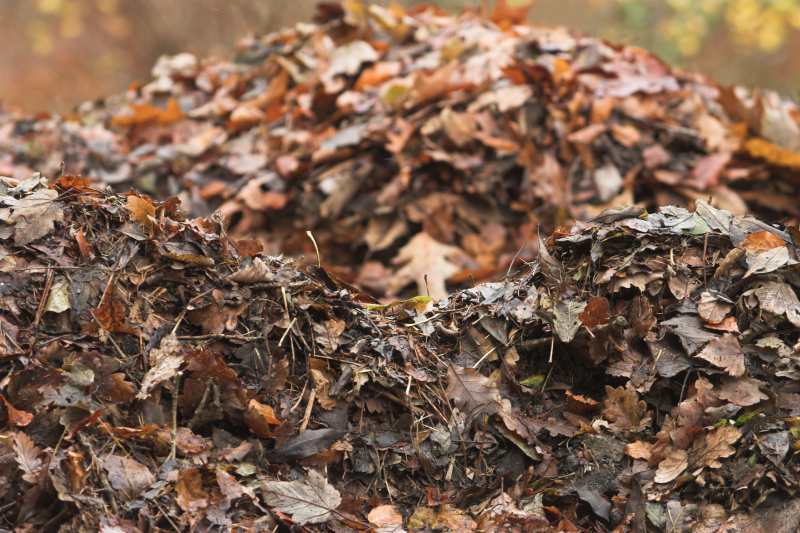
Partially decomposed fall leaves (AKA leaf mold) are excellent for controlling weeds and giving your garden a nutrient kickstart. They improve soil structure, add organic matter, and increase water retention so the soil can handle droughts.
If you don’t have time for leaves to decompose, or if you want to give pollinators a cozy winter habitat, opt for coarsely shredded dry leaves. They suppress weeds well, but they won’t prevent compaction like partially decomposed leaves.
As leaves decompose, you can dig them into the soil and add a fresh layer of mulch. Avoid adding leaves infected with anthracnose, scab, or leaf spot, as they can spread disease to your lawn. And don’t add leaves from black walnut trees: They contain juglone, which can harm veggies like peppers, eggplants, tomatoes, and potatoes.
Layer depth: 2 to 3 inches
Pros of leaves:
- Inexpensive or free
- Easy to access
- Decompose quickly to improve soil quality
- Certain leaves (oak and beech) are great for acid-loving veggies
Cons of leaves:
- Dry leaves blow away
- Wet leaves can form a stinky mat
- Dry leaves can be a fire hazard
- Finely shredded leaves prevent water infiltration
6. Pine needles
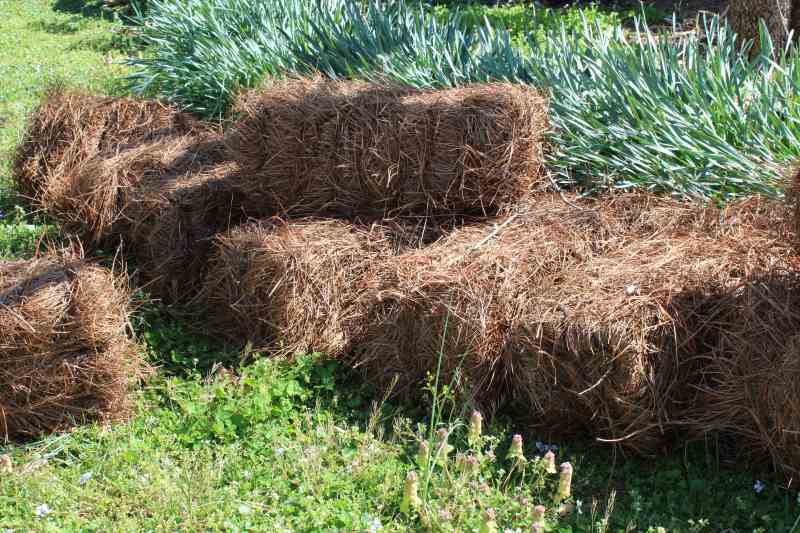
Pine needles, also known as pine straw, are perfect for acid-loving garden veggies like celery, cauliflowers, carrots, tomatoes, and potatoes. Pine needles interlock to stay in place, so they won’t blow away on windy days, and they resist soil compaction so your garden soil will stay healthy and porous.
While pine needles are great for acid-loving plants, don’t worry about them permanently acidifying your soil. As they decompose, they neutralize.
Layer depth: 3 to 4 inches
Read more : Desert Botanical Garden’s most popular events of 2023 are coming up. How to get tickets
Pros of pine needles:
- Long lifespan (2-4 years)
- Visually appealing
- Inexpensive or free
- Release pleasant aroma as they age
Cons of pine needles:
- Can be a fire hazard
- Won’t form a water-resistant mat (as grass clippings are prone to do)
- Not ideal for plants that prefer alkaline soil
7. Cocoa hulls
Cocoa bean hulls smell deliciously chocolatey and add functional elegance to your vegetable garden. They resist compaction and attract earthworms, so your soil will be light, airy, and nutrient-rich: Perfect for veggies!
Don’t place cocoa hulls in a pet-accessible area: They contain theobromine, which is toxic to dogs.
If you want a decorative garden mulch but can’t find cocoa hulls, consider buckwheat or cottonseed hulls. They boast the same mulching benefits as cocoa hulls and may be more readily available in your region.
Layer depth: 1 inch
Pros of cocoa hulls:
- Lightweight and easy to apply
- Strong weed suppression
- High visual appeal
- Long-lasting
- Excellent compaction resistance
Cons of cocoa hulls:
- Expensive
- Toxic to pets if consumed
- Prone to surface mold
- Damp cocoa hulls attract pests
- Unavailable in certain regions of the country
8. Newspaper
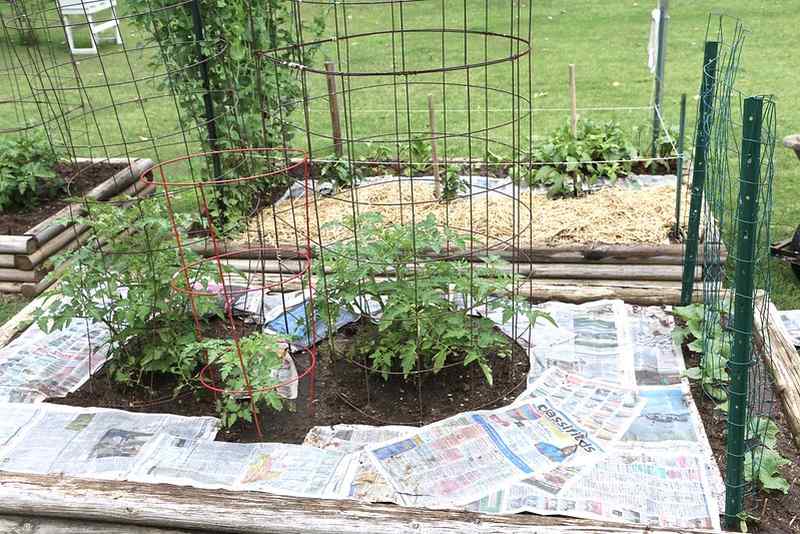
Don’t toss that day-old sports section! It could be your garden’s new best friend. Newspapers are excellent, biodegradable weed suppressors. If you have newspapers lying around, you have free mulch!
Soak sheets with water as you spread them so they stick together. Then, spread an organic mulch over the papers to hold them down and provide maximal insulation, weed protection, and compaction resistance.
As the newspaper decomposes, it returns nutrients to the soil and improves soil composition, but it can temporarily rob the soil surface of nitrogen. Apply nitrogen fertilizer before spreading the newspaper to keep your veggies healthy.
Turn newspaper into the soil at the end of the season.
Layer depth: 3 to 6 sheets
Pros of newspaper:
- Widely available
- Strong weed suppression
- Biodegradable
- Inexpensive or free
Cons of newspaper:
- Can attract rodents
- Visually unappealing
- Can prevent soil-air nutrient exchange
- Poor resistance to compaction
- Robs soil surface of nitrogen
Pro Tip: Don’t spread glossy color inserts over your soil. They won’t decompose like regular paper and can harm your plants.
Benefits of mulch for vegetable gardens
Mulch gives your vegetable garden a bounty of benefits.
- Suppresses weeds so veggies don’t have to compete with aggressive weeds (like dandelions and bindweed) for water and nutrients.
- Locks in soil moisture to prevent drought-induced problems (like blossom-end rot of tomato).
- Insulates the soil to protect roots from winter stress and encourage early growth in spring. Dark-colored mulches warm up the soil, while light-colored mulches keep it cool.
- Reduces erosion and runoff so the soil doesn’t float away during heavy rains or blow away during windstorms.
- Reduces the spread of soil-borne diseases by acting as a barrier and preventing soil splash. Cucumbers, tomatoes, and squash can rot if soil-borne disease organisms splash from the soil onto the plant.
Mulches to avoid in vegetable gardens
- Wood mulches: Wood ties up nitrogen at the soil surface as it decomposes, and this spells trouble for small vegetable plants. Using shredded pine bark mulch, wood chip mulch, or sawdust can lead to nitrogen deficiencies (marked by yellowing leaves and slow growth). You can avoid deficiencies by treating soil with fertilizer before mulching or simply by choosing a different mulch.
- Whole (unshredded) leaves: While dry shredded leaves are great for your vegetable garden, whole leaves form a dense mat over your soil, locking in too much moisture and not giving roots room to breathe. This leads to rot and fungal disease.
- Hay: Hay contains too many weed and grain seeds to provide a mulching benefit (with the exception of weed-free salt hay, which can be used). It should be avoided in favor of straw.
- Clear plastic mulch: Plastic heats up soil but doesn’t prevent weed growth, so there isn’t much use for it in a vegetable garden.
FAQ about mulching in your vegetable garden
When should I apply mulch to my garden?
Mid-spring is the best time to spread a healthy blanket of mulch around your vegetable garden. As temperatures begin to rise, mulch will insulate the soil and retain moisture for healthy plant growth. Hold off mulching in early spring when the weather is still cold, as mulching too early can slow down the warming process.Fall and winter mulching also can be beneficial, but make sure your mulch layer never surpasses 4 inches. Too much mulch can harm plant roots.Avoid mulching during the peak of summer. You don’t want to overheat your veggies!
How do I water plants under a black plastic tarp?
It’s best to install a drip irrigation system underneath the black plastic. While you can water with a sprinkler over the top, a drip system will deliver water straight to the roots.
How often should I use mulch?
Generally, you’ll want to spread mulch before each growing season, though it varies depending on what type of mulch you choose. Black plastic can last for years without replacement, while grass clippings may require multiple applications during the growing season.
How long does it take for leaf mulch to be ready?
Compost leaves for six to 18 months before mulching. Your leaf mulch is ready when it is friable (crumbly), drier than it originally was, and slightly above air temperature.
Growing vigorous veggies
Mulching means you can enjoy a bumper harvest of fresh vegetables without the hassle of weeding and constant watering. It’s a fantastic way to give your baby veggies the TLC they need to grow strong. If you’re ready to go mad for mulch, you can purchase it at your local garden center or create your own using the yard waste you have. Or, if you want someone to do the mulching for you, Lawn Love can connect you with a local lawn care pro.
Main Photo Credit: MementoImage | Canva Pro | License
Source: https://gardencourte.com
Categories: Garden news
